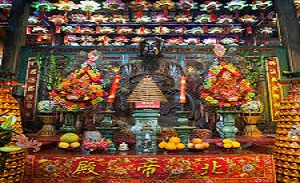The Taoist Altar
 Central to ceremonial forms of Taoist practice is the Taoist altar—the external representation of both Taoist cosmology and of the Internal Alchemical processes the practitioner undergoes on the path to Immortality. The specific arrangement of the altar varies from sect to sect and takes different forms also according to the particular ritual or ceremony that is being enacted. There are certain objects, however, that are always present, and whose symbolism remains basically the same, regardless of what form the ritual takes.
Central to ceremonial forms of Taoist practice is the Taoist altar—the external representation of both Taoist cosmology and of the Internal Alchemical processes the practitioner undergoes on the path to Immortality. The specific arrangement of the altar varies from sect to sect and takes different forms also according to the particular ritual or ceremony that is being enacted. There are certain objects, however, that are always present, and whose symbolism remains basically the same, regardless of what form the ritual takes.
Components of a Taoist Altar
Although altars vary depending on the sect and ceremony being practiced, most Taoist altars have the following elements:
- Sacred lamp: symbolizes the light of Tao
- Two candles: represent the moon/Yin and sun/Yang
- Three cups: union of the Yin and Yang
- Five plates of fruit: the five elements in their prenatal and postnatal form
- An incense burner: represents the lower abdominal area of the human body, where heat is produced
The Sacred Lamp
Placed in the center of the altar, in front of a picture or statue of the deity being honored, is the Sacred Lamp, which represents the light of Tao (the root of Wuji). This light of Tao, like the brightest of stars, shines both in the sky—illuminating the entire cosmos—and in the human body—illuminating our Original Nature. In terms of Inner Alchemy, it is called the Golden Pill or the Elixir of Immortality. It is never lit, nor extinguished, since the light of Tao—Primordial Wisdom—remains forever untouched by cycles of creation and dissolution.
Two Candles
To the left and right of the Sacred Lamp are two tall candles which represent the moon/Yin and sun/Yang. In terms of the human body, the two candles are original nature (Yuan Qi) and life (Hou Tian Qi), and also the two eyes. In the language of Inner Alchemy, they are the "Green Dragon and White Tiger copulating in the Yellow Hall."
Three Cups
In front of the Sacred Lamp are three cups. The cup on the left contains water, which represents Yang, or male generative energy. The cup on the right contains tea, which represents Yin, or female generative energy. The center cup contains grains of uncooked rice, which represent the union of Yin and Yang, since rice, in order to grow, absorbs the energy of both Earth/Yin and Sky/Yang.
Five Plates of Fruit
In front of the three cups are placed five plates of fruit and five bowls of food. The plates of fruit represent the five elements (wood, fire, earth, metal, and water) in their pre-natal, or Earlier Heaven form, characterized by a creative/supportive relationship between the elements. The bowls of food represent the five elements in their post-natal, or Later Heaven form, marked by a destructive/imbalanced relationship between the elements.
An Incense Burner
In front of the five plates and five bowls is an incense burner, which represents the lower abdominal area of the human body, called the “stove” or lower Dantian. This is where—in the practice of Inner Alchemy—heat is produced, which is used to purify and refine the Three Treasures (Jing, Qi, and Shen), three forms of energy found in the human body. Placed inside the incense burner are three sticks of incense, which represent these Three Treasures.
By Elizabeth Reninger
Source: learnreligions.com/

